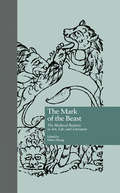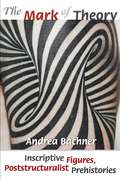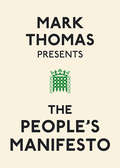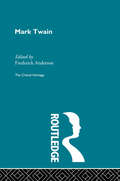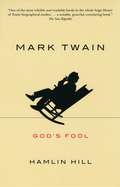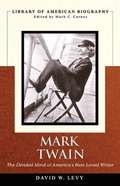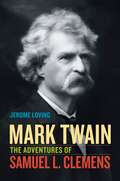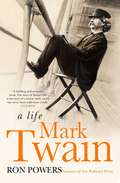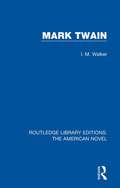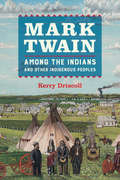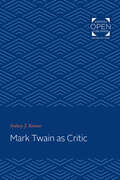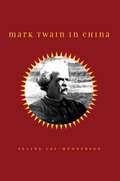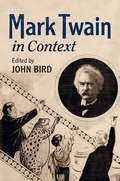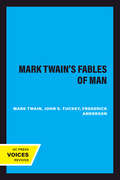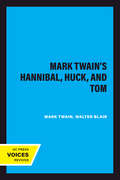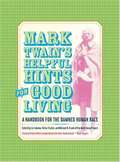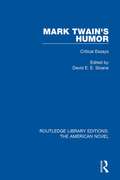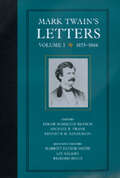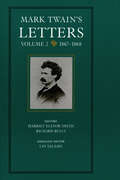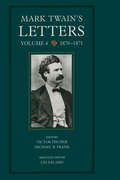- Table View
- List View
The Mark of the Beast: The Medieval Bestiary in Art, Life, and Literature (Garland Library of Medieval Literature #No. 22)
by Debra HassigThe medieval bestiary was a contribution to didactic religious literature, addressing concerns central to all walks of Christian and secular life. These essays analyze the bestiary from both literary and art historical perspectives, exploring issues including kinship, romance, sex, death, and the afterlife.
The Mark of Theory: Inscriptive Figures, Poststructuralist Prehistories
by Andrea BachnerWhat imaginaries, tropes, and media have shaped how we theorize? The Mark of Theory argues that inscription constitutes one of the master metaphors of contemporary theory.As a trope that draws on a wide array of practices of marking, from tattooing to circumcision, from photographic imprints and phonographic grooves to marks on a page, inscription provides an imaginary that orients and irritates theoretical thought. Tracing inscriptive imaginaries from the late nineteenth century to today, The Mark of Theory offers a wide-ranging conceptual genealogy of contemporary thought. Navigating poststructuralism’s attention to figurative language as well as media theory’s attention to objects, phenomena, and practices of mediation, the book works through core questions for how we theorize. Across a range of disciplines and scholarly conversations—from literature and media to anthropology, race and gender, art, psychoanalysis, sound, and ultimately ethics—sites of inscription come to constitute the past legacy of a thought to come, a prehistory of our current moment.In focusing on materiality and mediation The Mark of Theory shows how inscriptive practices shape conceptual thought, as well as political and ethical choices. By contextualizing the fraught relationship between materiality and signification, The Mark of Theory lays the ground for a politics of theory that begins there where theory and politics are no longer conflated.
Mark Steyn's Passing Parade: Obituaries And Appreciations
by Mark Steyn...on Bob Hope: He was the first comedian to run himself as a business, and he succeeded brilliantly. Time magazine reported in 1967 that he was worth half a billion dollars. Asked about the figure, Hope said, "Anyone can do it. All you have to do is save a million dollars a year for 500 years." ...on Amin: His Excellency was borne aloft in a sedan chair balanced with some difficulty on the shoulders of four spindly Englishmen from Kampala's business community, while another humbled honky walked behind holding the parasol. When it came to the white man's burden, the British could talk the talk. But that night the 3001b Amin made them walk the walk. ...on Strom Thurmond: Strom had just cast an appreciative bipartisan eye over the petite brunette liberal extremist. Senator Boxer gave an involuntary shudder. Glancing down, I was horrified to see an unusually large lizard slithering up and down my arm. On closer inspection, it proved to be Strom's hand. Presumably he'd mistaken my dainty elbow for Barbara's, but who knows? In how many other national legislatures can a guy just wander in off the street and find himself being petted by a 97-year-old Senator? ...on the Princess of Wales: August is the "silly season" in the British press, and this year the Princess had done her bit for her media chums, embarking on a dizzying summer romance that brought an extravagant array of her lover's ex-girlfriends tumbling out of the cupboard. A good time was had by all. On the very last day of the silly season, when the Queen's subjects woke to the news that Diana was dead, it seemed in some strange way the best plot twist of all. On Katherine Graham judging from the tone of the drooling eulogies, most commentators are apparently assuming that The Washington Post's proprietress will be continuing her salons in the unseen world and that, come their own demise, they want to make sure they're at the top table with Kay, the Kennedys, Pam Harriman, and not down the declasse end near the powder room with God, Christ, St Peter and the other losers. And for This Ole House: I was wandering way up in the mountains and came across this dilapidated cabin." He was hunting in the high Sierras and had noticed a mangy, starving old hound dog hanging around an otherwise abandoned cabin. "Inside, I found an old prospector lying dead. I saw curtains, so that meant a woman had been there. I saw kids' things lin' around. And they were all gone now. The old man was alone." Most of us would just get out, some perhaps would go to the cops, but Hamblen sat down and, with the corpse lying next to him for inspiration, began to rough out a song.
Mark Thomas Presents the People's Manifesto
by Mark ThomasMark Thomas has been touring the country for months, getting audiences to come up with policies aimed at sorting out the country's political chaos and taking back the power for the people. Sick to death of bailing out bankers and subsidising MPs homes, the audience vote on the best policy of the night to be included in the brand new People's Manifesto.From the inspiring to the downright hilarious, you'll wonder why these fantastic ideas aren't part of the constitution already. For example:- All politicians will be forced to wear the names and logos of the companies sponsor that them or with whom they have financial links.- Anyone who supports ID cards is banned from having curtains. - All models have to be picked at random from the electoral register.- Anyone found guilty of homophobic hate crime has to serve their sentence in drag.- CEOs convicted of fraud will be made to dress as pirates in whatever job they get in the future.The People's Manifesto will outline 50 policies of the manifesto shouted out in bold type on a page to themselves with Mark's commentary opposite. Mark has even 'road tested' some of them - like hosting a party in an MP's second home (which clearly belongs to the taxpayer) and getting university boffins to work out a way of SAT testing MPs to rank them by value. And Mark's guerrilla antics won't end there...Power to the people is really happening.
Mark Twain: The Critical Heritage (Mark Twain Papers #7)
by Frederick AndersonThis set comprises 40 volumes covering 19th and 20th century European and American authors. These volumes will be available as a complete set, mini boxed sets (by theme) or as individual volumes. This second set compliments the first 68 volume set of Critical Heritage published by Routledge in October 1995.
Mark Twain: God's Fool
by Hamlin Lewis HillAfter laughing their way through his classic and beloved depictions of nineteenth-century American life, few readers would suspect that Mark Twain's last years were anything but happy and joyful. They would be wrong. Contrary to the myth perpetrated by his literary executors Twain ended his life as a frustrated writer plagued by paranoia. He suffered personal tragedies, got involved in questionable business ventures, and was a demanding and controlling father and husband As Mark Twain: God's Fool demonstrates, the difficult circumstances of Twain's personal life make his humorous output all the more surprising and admirable "Ham[lin] Hill remains among the smartest, most honest, and most humane of Twain scholars--and . . . God's Fool parades those qualities on every page. " Jeff Steinbrink, Franklin & Marshall College "Fills a great, long-standing need for a thoroughly researched book about Mark Twain's twilight years. . . . Splendidly, grippingly written and excellently documented. . . . Likely to be a standard work for as long as anyone can foresee. "
Mark Twain: The Divided Mind of America's Best Loved Writer
by David W. LevyThe life and writings of a beloved American writer illuminate the Gilded Age and reveal his ambivalence toward the changes wrought by industry and wealth. Like the steamboat on which Mark Twain adopted his pen name, the industrial growth that swept America in the latter half of the nineteenth century prompted Americans to react variously with delight, awe, fear, excitement for the future, and nostalgia for a simpler time. David Levy's biography places Mark Twain and his work in the context of sweeping societal changes: westward expansion, the Civil War, American imperialism, the end of slavery and start of a new chapter in race relations, and the advances and excesses of the Gilded Age. Paperback, brief, and inexpensive, each of the titles in the Library of American Biography series focuses on a figure whose actions and ideas significantly influenced the course of American history and national life. In addition, each biography relates the life of its subject to the broader themes and developments of the times.
Mark Twain
by Jerome LovingMark Twain, who was often photographed with a cigar, once remarked that he came into the world looking for a light. In this new biography, published on the centennial of the writer's death, Jerome Loving focuses on Mark Twain, humorist and quipster, and sheds new light on the wit, pathos, and tragedy of the author of Adventures of Huckleberry Finn. In brisk and compelling fashion, Loving follows Twain from Hannibal to Hawaii to the Holy Land, showing how the southerner transformed himself into a westerner and finally a New Englander. This re-examination of Twain's life is informed by newly discovered archival materials that provide the most complex view of the man and writer to date.
Mark Twain: A Life
by Ron PowersIf Mark Twain was the seminal American writer, he was also an international celebrity whose life was every bit as extraordinary as his writing. Ron Powers, an award-winning author and critic with twenty years' worth of experience studying Twain and his art, combines enormous learning with wonderful storytelling in a masterful story of the man behind the writing. Twain's story is epic, comic and tragic. To retrace it all in illuminating detail, Powers draws on the tens of thousands of Twain's letters and on his astonishing journal entries - many of which are quoted here for the first time. Twain left Missouri for a life on the Mississippi during the golden age of steamboats, enjoyed an uproariously drunken newspaper career in the Nevada of the Wild West, and witnessed and joined the extremes of wealth and poverty of New York City and of the Gilded Age. Through it all he observed, borrowed, stole and combined the characters he met into the voice of America's greatest literature, attracting throngs of fans wherever his undying lust for wandering took him. From Twain's wicked satire to his relationships with the likes of Ulysses Grant, this is a brilliantly written story that astounds, amuses and edifies as only a great life can.
Mark Twain
by Forrest G. RobinsonThis collection of captivating tales displays Twain's characteristic energy, imagination, and sense of fun, as well as the darkly satirical edge that marks so much of his work. His targets range from the difficulty of learning German (explored in a three-act play where two young lovers are obliged to conduct their courtship in beginning German), to the incompetence of military command (found in a sketch called "Luck" in which it is revealed that a celebrated general's most lauded battle stratagem resulted from his confusing his right hand with his left). The best-known story in this collection is "The Private History of a Campaign That Failed," one of the few pieces Twain ever wrote about his experiences in the Civil War. His friend William Dean Howells found it "immensely amusing, with such a bloody bit of heartache in it. " As Anne Bernays writes in her introduction, "unmatched in the care and handling of tone ," "The Private History of a Campaign That Failed" is "a merry tale about shattered innocence and slaughter, an antiwar manifesto that is also confession, dramatic monologue. . . and a romp that gradually turns into atrocity even as we watch. " It is a small masterpiece.
Mark Twain (Routledge Library Editions: The American Novel #16)
by I. M. WalkerOriginally published in 1970. Mark Twain is generally known as a children’s writer. This serious and appreciative introduction by I. M. Walker shows that he is in fact a great writer who produced mature and developed literature. The study of his works is divided into five sections: the comic narrator; techniques of humour; character portrayal; style and description; and irony and satire.
Mark Twain among the Indians and Other Indigenous Peoples
by Kerry DriscollMark Twain among the Indians and Other Indigenous Peoples is the first book-length study of the writer’s evolving views regarding the aboriginal inhabitants of North America and the Southern Hemisphere, and his deeply conflicted representations of them in fiction, newspaper sketches, and speeches. Using a wide range of archival materials—including previously unexamined marginalia in books from Clemens’s personal library—Driscoll charts the development of the writer’s ethnocentric attitudes about Indians and savagery in relation to the various geographic and social milieus of communities he inhabited at key periods in his life, from antebellum Hannibal, Missouri, and the Sierra Nevada mining camps of the 1860s to the progressive urban enclave of Hartford’s Nook Farm. The book also examines the impact of Clemens’s 1895–96 world lecture tour, when he traveled to Australia and New Zealand and learned firsthand about the dispossession and mistreatment of native peoples under British colonial rule. This groundbreaking work of cultural studies offers fresh readings of canonical texts such as The Adventures of Tom Sawyer, A Connecticut Yankee in King Arthur’s Court, Roughing It, and Following the Equator, as well as a number of Twain’s shorter works.
Mark Twain as Critic
by Sydney J. KrauseOriginally published in 1967. Mark Twain's literary criticism is a significant branch of his writing that is relatively less explored and appreciated than his other writing. Sydney Krause analyzes the full range of Twain's criticism, much of which has lain neglected in notebooks, letters, marginalia, and autobiographical dictations. This body of work demonstrates that, in addition to being an acute critic given to close reading, Twain thought enough of his criticism to present much of it in an enveloping literary form. In his early criticism Twain used the mask of an ignorant fool (or Muggins), while in his later criticism he used the mask of a world-weary malcontent (or Grumbler). The resulting cross fire from extremes of innocence and experience proved effective against a wide range of literary targets. The Muggins dealt mainly with theater, journalism, oratory, and popular poetry; the grumbler with such writers as Goldsmith, Cooper, Scott, and Hare. Much of this criticism was an outgrowth of Twain's romanticism and therefore has importance for the history of American realism. Mark Twain's criticism was not wholly depreciatory, however. He liked Macaulay, Howells, Howe, Zola, and Wilbrandt, for example, because he found in some of their works the realization of history as an immediate presence. The evidence presented in this book challenges the view that Twain was not a serious student of the craft of writing; he possessed the combination of sensitivity and judgment that all great critics have.
Mark Twain in China
by Selina Lai-HendersonMark Twain (Samuel Langhorne Clemens, 1835-1910) has had an intriguing relationship with China that is not as widely known as it should be. Although he never visited the country, he played a significant role in speaking for the Chinese people both at home and abroad. After his death, his Chinese adventures did not come to an end, for his body of works continued to travel through China in translation throughout the twentieth century. Were Twain alive today, he would be elated to know that he is widely studied and admired there, and that Adventures of Huckleberry Finn alone has gone through no less than ninety different Chinese translations, traversing China, Taiwan, and Hong Kong. Looking at Twain in various Chinese contexts--his response to events involving the American Chinese community and to the Chinese across the Pacific, his posthumous journey through translation, and China's reception of the author and his work, Mark Twain in China points to the repercussions of Twain in a global theater. It highlights the cultural specificity of concepts such as "race," "nation," and "empire," and helps us rethink their alternative legacies in countries with dramatically different racial and cultural dynamics from the United States.
Mark Twain in Context (Literature in Context)
by John BirdMark Twain In Context provides the fullest introduction in one volume to the multifaceted life and times of one of the most celebrated American writers. It is a collection of short, lively contributions covering a wide range of topics on Twain's life and works. Twain lived during a time of great change, upheaval, progress, and challenge. He rose from obscurity to become what some have called 'the most recognizable person on the planet'. Beyond his contributions to literature, which were hugely important and influential, he was a businessman, an inventor, an advocate for social and political change, and ultimately a cultural icon. Placing his life and work in the context of his age reveals much about both Mark Twain and America in the last half of the nineteenth century, the twentieth century, and the first decades of the twenty-first century.
Mark Twain's Correspondence with Henry Huttleston Rogers, 1893-1909
by Lewis LearyThis collection of correspondence between Clemens and Rogers documents Clemens's progress from financial disaster, with the Paige typesetter and Webster & Company, to renewed prosperity under the steady, skillful hand of H. H. Rogers.
Mark Twain's Fables of Man (Mark Twain Papers #7)
by Mark TwainFor years, many of Twain’s philosophical, religious, and historical fantasies concerning the nature and condition of humanity remained unpublished. Thirty-six of these writings make their first appearance here.
Mark Twain's Hannibal, Huck, and Tom (Mark Twain Papers #5)
by Mark TwainThis volume provides authoritative texts of Twain’s unpublished writings, both fictional and factual, about the people and places of his home town, Hannibal, Missouri.A significant part of only one of them, "Jane Lampton Clemens," has been published; it was inserted unjustifiably in Twain's Authobiography . Written soon after the death of Clemens's mother on 27October 1890, it arranges and assesses a son's recollections of a vibrant personality important in shaping his life. At the start the author turns to the time when he, a six-year-old, knelt with his mother by the bed on which his dead brother lay—a harassing experience that understandably seared the boy's memory. The sketch moves on to a host of details about antebellum Hannibal, its society and its attitudes toward slavery, and to vivid memories about the child, his mother, and his father in the 1840's and 1850's. The movement from a single remembered episode to a series of loosely associated recollections was a typical performance in Clemens's "autobiography" and his fiction.
Mark Twain's Helpful Hints for Good Living: A Handbook for the Damned Human Race
by Mark Twain Lin Salamo Victor Fischer Michael B. Frank"This handbook -- an etiquette guide for the human race -- contains sixty-nine aphorisms, anecdotes, whimsical suggestions, maxims, and cautionary tales from Mark Twain's private and published writings. It dispenses advice and reflections on family life and public manners; opinions on topics such as dress, health, food, childbearing, and safety; and more specialized tips, such as those for dealing with annoying salesmen and burglars. Culled from Twain's personal letters, autobiographical writings, speeches, novels, and sketches, these pieces are fresh, witty, startlingly relevant with Twain's characteristic ebullience. They also remind us exactly how Mark Twain came to be the most distinctive and well-known American literary voice in the world."--BOOK JACKET. Title Summary field provided by Blackwell North America, Inc. All Rights Reserved
Mark Twain's Humor: Critical Essays (Routledge Library Editions: The American Novel #14)
by David E. E. SloaneOriginally published in 1993. The purpose of this volume is to lay out documents which give an estimate of Mark Twain as a humourist in both historical scope and in the analysis of modern scholars. The emphasis in this collection is on how Twain developed from a contemporary humourist among many others of his generation into a major comic writer and American spokesman and, in several more recent essays by younger Twain scholars, the outcomes of that development late in his career. The essays determine how the humor takes on meaning and importance and how the humor works in a number of ways in the literary canon and even in the persona of Mark Twain.
Mark Twain's Letters, Volume 1: 1853-1866 (Mark Twain Papers #9)
by Mark TwainThis title is part of UC Press's Voices Revived program, which commemorates University of California Press’s mission to seek out and cultivate the brightest minds and give them voice, reach, and impact. Drawing on a backlist dating to 1893, Voices Revived makes high-quality, peer-reviewed scholarship accessible once again using print-on-demand technology. This title was originally published in 1988.This title is part of UC Press's Voices Revived program, which commemorates University of California Press’s mission to seek out and cultivate the brightest minds and give them voice, reach, and impact. Drawing on a backlist dating to 1893, Voices Revived</DIV
Mark Twain's Letters, Volume 2: 1867-1868 (Mark Twain Papers #9)
by Mark TwainHere is young Sam Clemens—in the world, getting famous, making love—in 155 magnificently edited letters that trace his remarkable self-transformation from a footloose, irreverent West Coast journalist to a popular lecturer and author of The Jumping Frog, soon to be a national and international celebrity. And on the move he was—from San Francisco to New York, to St. Louis, and then to Paris, Naples, Rome, Athens, Constantinople, Yalta, and the Holy Land; back to New York and on to Washington; back to San Francisco and Virginia City; and on to lecturing in Ohio, Michigan, Pennsylvania, and New York. Resplendent with wit, love of life, ambition, and literary craft, this new volume in the wonderful Bancroft Library edition of Mark Twain's Letters will delight and inform both scholars and general readers.This volume has been supported by the National Endowment for the Humanities, the Mark Twain Foundation, Jane Newhall, and The Friends of The Bancroft Library.
Mark Twain's Letters, Volume 4: 1870–1871 (Mark Twain Papers #9)
by Mark Twain"You ought to see Livy & me, now-a-days—you never saw such a serenely satisfied couple of doves in all your life. I spent Jan 1, 2, 3 & 5 there, & left at 8 last night. With my vile temper & variable moods, it seems an incomprehensible miracle that we two have been right together in the same house half the time for a year & a half, & yet have never had a cross word, or a lover's 'tiff,' or a pouting spell, or a misunderstanding, or the faintest shadow of a jealous suspicion. Now isn't that absolutely wonderful? Could I have had such an experience with any other girl on earth? I am perfectly certain I could not. . . . We are to be married on Feb. 2d."So begins Volume 4 of the letters, with Samuel Clemens anticipating his wedding to Olivia L. Langdon. The 338 letters in this volume document the first two years of a loving marriage that would last more than thirty years. They recount, in Clemens's own inimitable voice, a tumultuous time: a growing international fame, the birth of a sickly first child, and the near-fatal illness of his wife.At the beginning of 1870, fresh from the success of The Innocents Abroad, Clemens is on "the long agony" of a lecture tour and planning to settle in Buffalo as editor of the Express. By the end of 1871, he has moved to Hartford and is again on tour, anticipating the publication of Roughing It and the birth of his second child. The intervening letters show Clemens bursting with literary ideas, business schemes, and inventions, and they show him erupting with frustration, anger, and grief, but more often with dazzling humor and surprising self-revelation. In addition to Roughing It, Clemens wrote some enduringly popular short pieces during this period, but he saved some of his best writing for private letters, many of which are published here for the first time.
